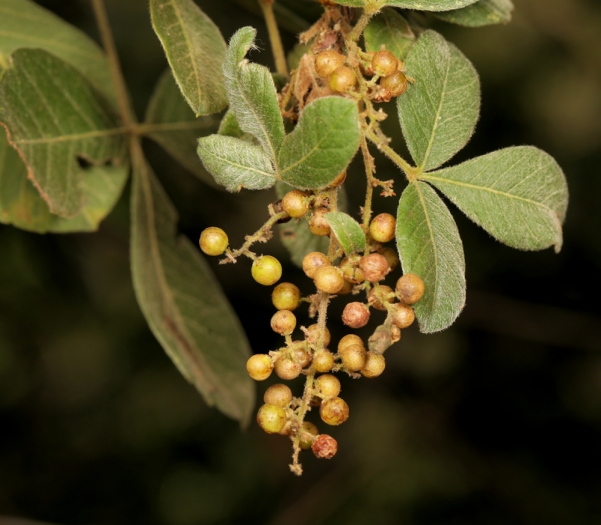African Tannin
(Searsia pyroides)
African Tannin (Searsia pyroides)
/
/

Wynand Uys
CC BY 4.0
Image By:
Wynand Uys
Recorded By:
Copyright:
CC BY 4.0
Copyright Notice:
Photo by: Wynand Uys | License Type: CC BY 4.0 | License URL: http://creativecommons.org/licenses/by/4.0/ | Rights Holder: Wynand Uys | Publisher: iNaturalist | Date Created: 2020-05-12T12:09:55-07:00 |

























Estimated Native Range
Summary
Searsia pyroides, commonly known as the African Tannin or Fire Thorn Tree, is a deciduous tree or large shrub native to a variety of habitats in southern Africa, including South Africa, Botswana, Zimbabwe, Tanzania, and Namibia. It is often found in bushveld, savannas, dry thornveld, rocky hillsides, along termite mounds, and near watercourses. Searsia pyroides typically reaches heights of up to 16 feet (5 meters) and has a variable, thorny, and bushy appearance. The tree is well-adapted to its environment, with trifoliolate leaves that are drought-resistant. During the summer months, it produces small, inconspicuous greenish flowers, which are followed by red fruits on female trees. These fruits are attractive to birds and serve as a food source, while the tree itself is a host plant for the moth Xylopteryx arcuata, contributing to local biodiversity.
The Fire Thorn Tree is valued for its hardiness and ability to thrive in arid conditions, making it suitable for xeriscaping and as a windbreak in dry regions. It is also used for erosion control and can be planted as an informal hedge or security barrier due to its thorny nature. In cultivation, it requires minimal maintenance, tolerating poor soils and drought once established. It prefers full sun to light shade and benefits from well-drained soil. However, gardeners should be aware of its thorns when planting in areas frequented by people and pets.CC BY-SA 4.0
The Fire Thorn Tree is valued for its hardiness and ability to thrive in arid conditions, making it suitable for xeriscaping and as a windbreak in dry regions. It is also used for erosion control and can be planted as an informal hedge or security barrier due to its thorny nature. In cultivation, it requires minimal maintenance, tolerating poor soils and drought once established. It prefers full sun to light shade and benefits from well-drained soil. However, gardeners should be aware of its thorns when planting in areas frequented by people and pets.CC BY-SA 4.0
Plant Description
- Plant Type: Tree, Shrub
- Height: 6-12 feet
- Width: 6-10 feet
- Growth Rate: Moderate
- Flower Color: Yellow
- Flowering Season: Spring
- Leaf Retention: Deciduous
Growth Requirements
- Sun: Full Sun
- Water: Low
- Drainage: Medium, Fast
Common Uses
Drought Tolerant, Erosion Control, Low Maintenance
Natural Habitat
Native to a variety of habitats including bushveld, savannas, dry thornveld, rocky hillsides, along termite mounds, and near watercourses
Other Names
Common Names: Common Taaibos, Bitter Taaibos, Brandblaar, Brandblaar Taaibos
Scientific Names: , Searsia pyroides, Rhus baurii, Rhus intermedia, Rhus puberula, Rhus pyroides, Rhus steudneri, Rhus tridentata, Rhus tridentata var. integrifolia, Rhus villosa
GBIF Accepted Name: